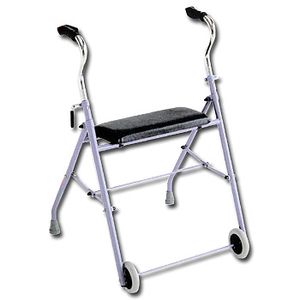Walkers
Original Editor - The Open Physio project.
Top Contributors - Lucinda hampton, Lauren Lopez, Admin, Jess Bell, Kim Jackson, Jeremy Bryan, Rachael Lowe, Abbey Wright, Larisa Hoffman, Robin Tacchetti, Ammar Suhail, WikiSysop, Redisha Jakibanjar and Naomi O'Reilly
Introduction[edit | edit source]
A walker is a walking aid that has four points of contact with the ground and usually has three sides with the side closest to the patient being open. It provides a wider base of support than a walking stick and so is used more to stabilise patients with poor balance.
Types of Walkers [edit | edit source]
Many walkers exists on the market and a physiotherapist is well placed to be instrumental in choosing the correct walker for the differing needs of clients.
- Wheels on all four legs, with or without brakes
- Two front legs with two rear casters
- Two front legs and two rear wheels with brakes which operate on downward pressure on the wheels
- "Square" wheels
- Ability to be folded, which makes travelling with the frame easier
- Trays, seats and baskets may be attached
- Other modifications such as a light that projects a red line on the ground in order to guide step length in individuals with Parkinsons
Usage[edit | edit source]
Walkers should be adjustable in height, which is measured in the same way as one would measure for a walking stick. A frame with four legs and a wide base, known as a Zimmer frame is used in the following way if WB on both legs.The patient:
- Picks it up
- Moves it forwards
- Places it in front of them
- Leans on the frame, taking weight through the upper limbs
- Walks into it (the patient should be encouraged to take two small, even steps to avoid a disordered gait pattern)







